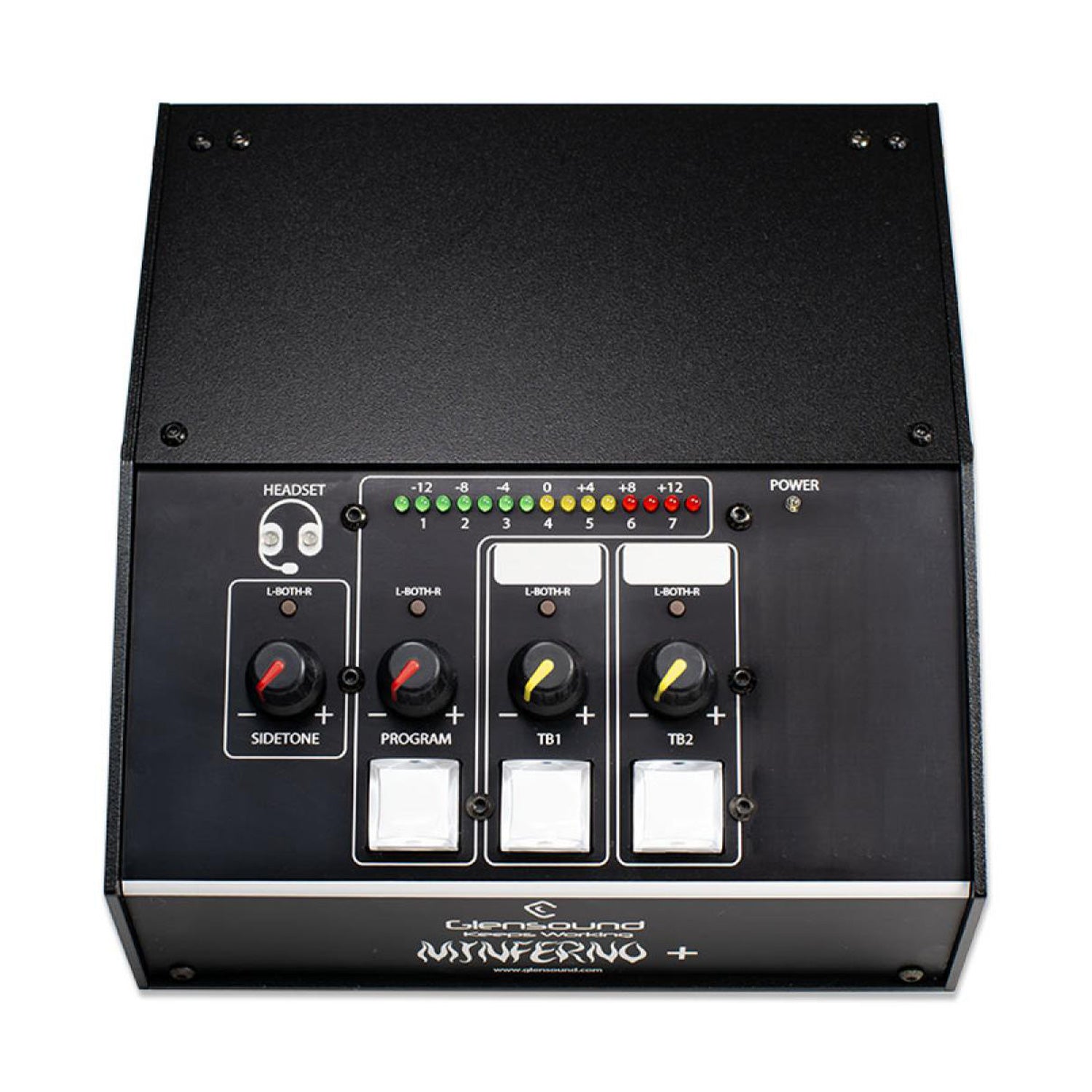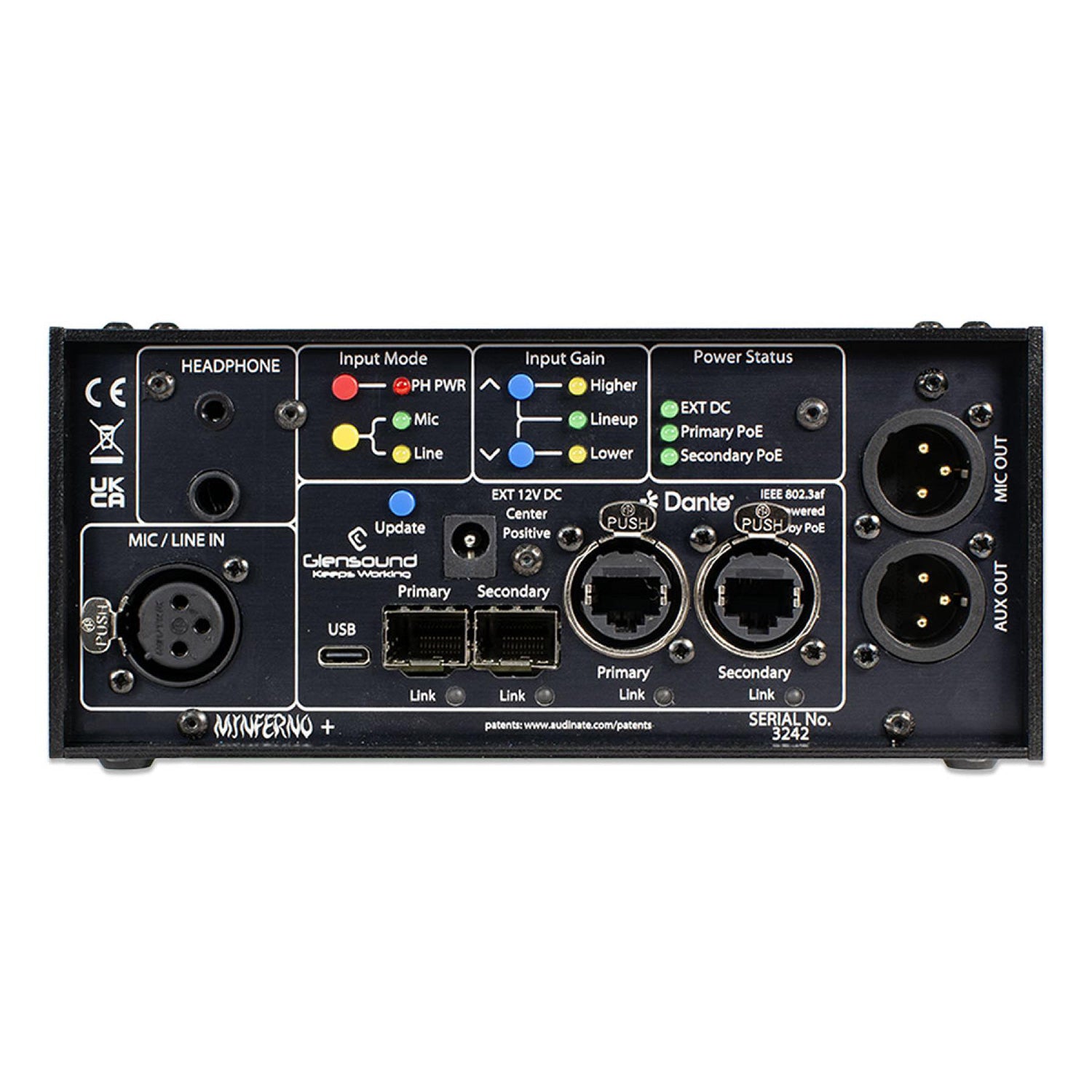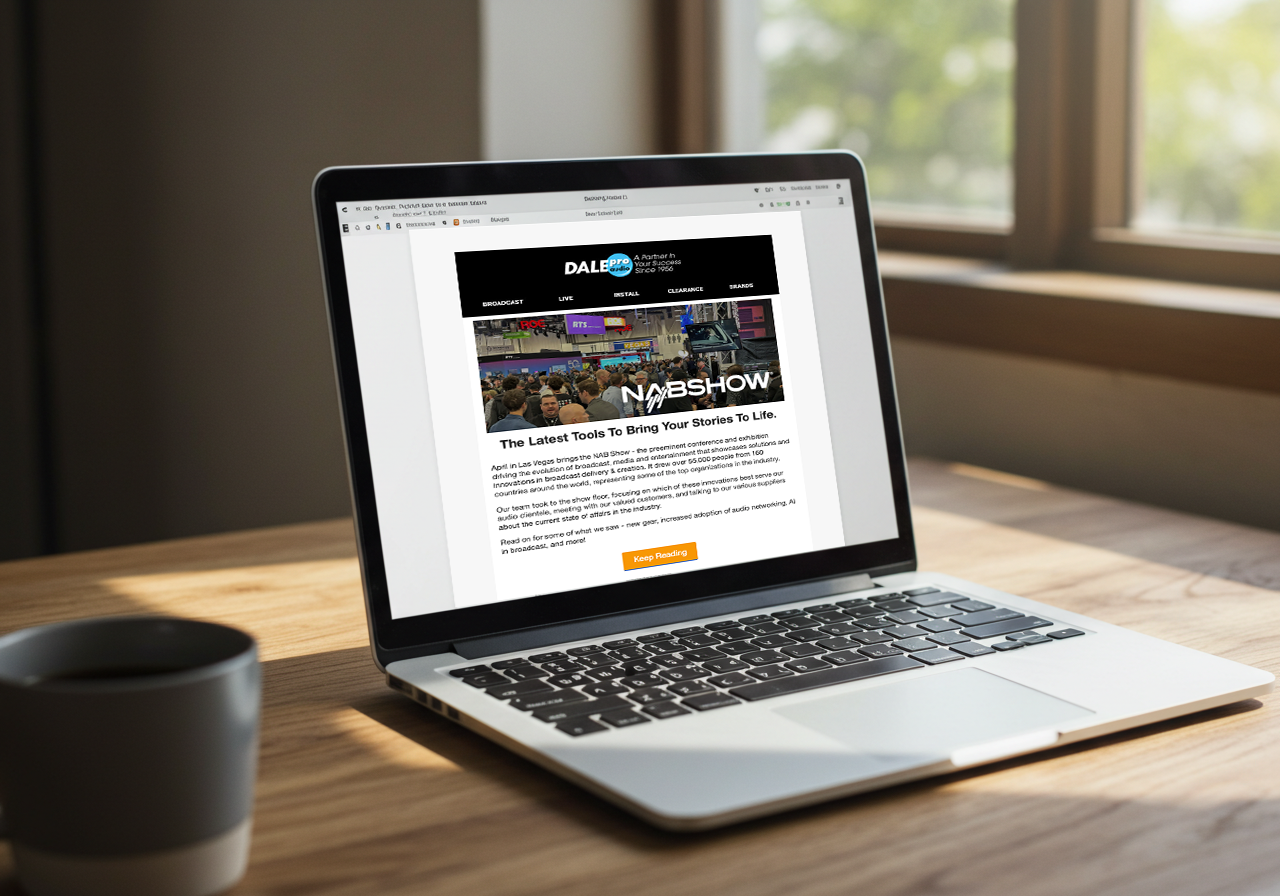

Glensound MinFerno/2 Plus - Single-Channel Dante Commentary Unit with Analog Mic Outputs
Availability:
Special Order ItemThis item is not stocked and needs to be ordered from the manufacturer. Please contact our sales team for more information.

Description
MinFerno/2+ is a single user Dante commentary box. It can connect to any Dante compatible network. It has a single low noise mic/line/48V input, and Glensound's popular Referee compressor/limiter keeps even the loudest commentator sounding natural. The onboard headphone mixer has 3 inputs supplied from the Dante network, plus the local input (sidetone). Each headphone input has left/both/right headphone switching. The main output plus 2 talkback onto network is via Dante or Ravenna, and an analogue switched output of mic input is on the rear panel for redundancy in case of network failure. Multiple power options include PoE and External DC. Network connections are on Copper (Cat5) and Fibre (SFP slots), and primary / secondary network connections allowing completely transparent network redundancy. Control is via an inbuilt web server for setup and remote control via web browser of mic gain / mic on/off switch.
Redundant Powering Options
The MinFerno can be powered from any of 3 different sources:
1) PoE on the Primary CAT5 Network link
2) PoE on the Secondary CAT5 Network link
3) External 12V DC
Four of rear panel LEDs show the availability of the 3 power sources.
Primary / Secondary SFP Slots
The SFP (Small Form-Factor Pluggable) fibre slots are standard networking ports that accept standard SFP modules. This means that you decide what type of fibre and connector style you want to use just by the SFP module that you insert. The primary and secondary network circuits allow for glitch free redundancy across both the Fibre and Copper network interfaces.
Primary / Secondary Copper Network Connections with PoE
Two CAT6 connections on Neutrik Ethercons (that accept standard networking cables) are provided to allow copper connections to local network switches to carry the Dante/ AES67 audio. Two connections are fitted to allow redundant circuits to be used if required. Both of these connectors can accept a PoE power source for providing the power to the MinFerno.
Input Mode / Gain
One pair of push buttons selects the input type of the front panel XLR to be either microphone, line or microphone with 48V phantom power. 3 LEDs indicate which input mode is selected. Two push buttons are used to alter the gain of the input. LEDs indicate if the gain setting is above or below our pre-configured 'lineup' levels. The front panel PPM of course provides an accurate indication of the input level. The gain can also be altered remotely by a web browser pointing at the MinFerno's web page.
3 Incoming Audio Volume Controls
On the top panel are 3 rotary headphone volume controls. These are connected to the incoming audio circuits from the Dante/ AES67 network. These are normally used for such sources as mixed programme or cue, talkback to director, talkback to producer, talkback to engineer etc.
Sidetone Volume Control
The 4th front panel rotary headphone volume control is 'sidetone'. Sidetone is the commentator's own voice in their own ears.
Headphone Routing
Each of the 4 headphone volume controls has an associated left ear, right ear, both routing switch located next to the volume knob. This single push button switch routes the associated source to just the left, just the right or both channels of the stereo headphone amplifier.
To enable the commentator to know how they are routing a circuit the first time a routing switch is pressed, a pair of LEDs on the front panel indicate its current routing arrangement. The next time the routing switch is pressed then the next routing option is selected.
Robust Mic On and Talkback Buttons
There are 3 large bright illuminated buttons (1 for programme and 2 for talkback). These switches route the outgoing microphone circuit onto 3 different Dante/ AES67 network audio circuits. The operation of these switches (momentary, latching etc) and the interaction of these switches (i.e. pressing a talkback switch mutes the main mic) can be fully configured via the web page.
Analogue Mic Output
A three pin XLR is on the rear panel containing the analogue output of the mic/line input. This is switched/muted with the top panel buttons. This is typically used as an analogue mic output in case the network fails.
15 segment LED PPM Meter
Audio input level is indicated on the 15 segment PPM meter.
Low Noise Microphone Amplifier With Remote Gain
We spent a long time optimising the performance of the THAT corporation microphone amplifier used in the original Inferno and used again on the MinFerno. It features very low noise and distortion circuit that we remote control the gain of in 1dB steps, which allows us to provide the remote webpage gain control as well as the rear panel gain push buttons. We also optimised the circuits to allow correct source impedance switching depending on whether the input has been set as a mic or line input.
Referee Compressor Limiter
As with all our commentary units, the MinFerno features our very popular Referee compressor limiter circuit. This circuit starts to compress the commentator's voice gradually and slowly increases the compression ratio as the input level becomes overly high, resulting in a very natural sounding and distortion free audio output capable of taming even the loudest of commentators.
High Quality Analogue To Digital Converter (ADC)
Dante/ AES67 network audio is a digital circuit and as such the best analogue microphone amplifier would be wasted if we hadn't paired it up with the best analogue to digital converter. The ADC's job is fairly simple, and if you look at our tech spec you'll see that we've made ours work incredibly well.
Unique Headphone Amplifiers
The commentator's headphones are a vitally important tool so we take as much care with our headphone amplifiers as with our on air microphones. Our unique headphone amplifier provides the correct output level regardless of the impedance of the attached headphones, meaning that broadcasters can now pick and choose between low impedance 'cheap' headphones and high impedance traditional broadcast ones.
| AUDIO INPUT | |
| Input Type | Neutrik 3 pin XLR |
| Input Impedance | Mic: 2k4 Line 100k |
| Equivalent Input Noise | 127dBu (22Hz-22KHz) RMS A weighted Terminated with 300 Ohms |
| Frequency response | Mic -2dBu @25Hz flat @50Hz till 22kHz (+/- 0.25dBu). Line flat till 22kHz |
| Distortion at +8dBu | 100Hz = 0.023% 1kHz =0.012% 10kHz = 0.014% |
| Line Up Gains | Dynamic Mic: 58dB Mic + Phantom Power: 35dB Line: 0dB |
| Gain Range | Mic: -30 to +15dB Line: +/-15dB |
| Max Input Before Clipping (@line up) | Dynamic Mic: +10dBU, Mic+phantom: +18dBu Line: +18dBu |
| AUDIO OUTPUT | |
| Output type | Analogue 3 pin XLR Switching: Switched/muted with top panels buttons as configured |
| HEADPHONES | |
| Headphone Impedance | 16-1000 Ohms (auto output level to match impedance) |
| Headphone Noise | -76.6dB @ line up (residual noise) |
| Headphone Frequency Response | >-0.1dB 22Hz to 22kHz |
| Headphone THD + Noise (Ref +8dB) | 0.008% @ 1kHz |
| Connection | 6.35mm / 3.5mm stereo jack plugs |
| Headphone Volume Pot Range | +10dB to Off (can be configured +10dB to -30dB) |
| Maximum Headphone Output | +16.8dB into 600 Ohms |
| POWER | |
| PoE | Can be powered by PoE on either Copper network interface Complies to IEEE 802.3af-2003 classification class 0 |
| DC Input | 2.5mm Barrel, Centre +Ve, 9 - 15 Volts |
| Front Panel Power On LED | Bright Blue |
| Rear Panel Power On Indicators | 1 green LED showing presence of each of the above power sources |
| PHYSICAL | |
| Size | 144 x 179 x 76mm (WxDxH) |
| Weight | 1.01Kg (2lb3oz) |
| Mechanics | All aluminium construction, anodised and laser etched, powder coated sides |
| Shipping Carton | Rugged Export Quality cardboard carton 610 x 420 x 170mm (WxDxH) |
| Shipping Weight | 2.5kg |
| ENVIRONMENTAL | |
| Operating Temperature | 0 to +50¡C (32 to 122¡F) |
| Storage Temperature | -20 to +70¡C (-4 to 158¡F) |
| Relative Humidity | 0 to 95% non-condensing |
| INCLUDED ITEMS | |
| Handbook | Handbook can be downloaded |
| Mains Cable | UK / EU only, 2 metre mains plug to IEC |
| RJ45 Network Cable | 1 of 2 Metre |
| OPTIONAL ITEMS | |
| Carrying Case | Polypropylene Carrying Case |
| SFP Fibre Modules | Multi Mode, Single Mode and Bi-directional on single Fibre available |
| External DC Power Supply | Switch mode (100 - 250VAC) desktop style with IEC mains input / 1.5 metre DC output cable |
| NETWORK OPTIONS | |
| DANTE/AES67 VERSION | Physical: 2 x Neutrik Ethercons Cat6 RJ45s / 2 x SFP slots Type: Fully redundant primary / secondary circuits Sample Frequency: 48K Resolution: 24 Bit Control / Routing: Via Free Dante Controller AES67: Can be configured for AES67 |
| RAVENNA/AES67 VERSION | Physical: 2 x Neutrik Ethercons Cat6 RJ45s / 2 x SFP slots Type: Fully redundant primary / secondary circuits AES67: Yes High Sample Rates: 44.1kHz - 192kHz PTPv2: Master or Slave, IEEE-1588-2008 standard SMPTE ST 2110-30: Yes. Including level C and CX |
MinFerno/2+ is a single user Dante commentary box. It can connect to any Dante compatible network. It has a single low noise mic/line/48V input, and Glensound's popular Referee compressor/limiter keeps even the loudest commentator sounding natural. The onboard headphone mixer has 3 inputs supplied from the Dante network, plus the local input (sidetone). Each headphone input has left/both/right headphone switching. The main output plus 2 talkback onto network is via Dante or Ravenna, and an analogue switched output of mic input is on the rear panel for redundancy in case of network failure. Multiple power options include PoE and External DC. Network connections are on Copper (Cat5) and Fibre (SFP slots), and primary / secondary network connections allowing completely transparent network redundancy. Control is via an inbuilt web server for setup and remote control via web browser of mic gain / mic on/off switch.
Redundant Powering Options
The MinFerno can be powered from any of 3 different sources:
1) PoE on the Primary CAT5 Network link
2) PoE on the Secondary CAT5 Network link
3) External 12V DC
Four of rear panel LEDs show the availability of the 3 power sources.
Primary / Secondary SFP Slots
The SFP (Small Form-Factor Pluggable) fibre slots are standard networking ports that accept standard SFP modules. This means that you decide what type of fibre and connector style you want to use just by the SFP module that you insert. The primary and secondary network circuits allow for glitch free redundancy across both the Fibre and Copper network interfaces.
Primary / Secondary Copper Network Connections with PoE
Two CAT6 connections on Neutrik Ethercons (that accept standard networking cables) are provided to allow copper connections to local network switches to carry the Dante/ AES67 audio. Two connections are fitted to allow redundant circuits to be used if required. Both of these connectors can accept a PoE power source for providing the power to the MinFerno.
Input Mode / Gain
One pair of push buttons selects the input type of the front panel XLR to be either microphone, line or microphone with 48V phantom power. 3 LEDs indicate which input mode is selected. Two push buttons are used to alter the gain of the input. LEDs indicate if the gain setting is above or below our pre-configured 'lineup' levels. The front panel PPM of course provides an accurate indication of the input level. The gain can also be altered remotely by a web browser pointing at the MinFerno's web page.
3 Incoming Audio Volume Controls
On the top panel are 3 rotary headphone volume controls. These are connected to the incoming audio circuits from the Dante/ AES67 network. These are normally used for such sources as mixed programme or cue, talkback to director, talkback to producer, talkback to engineer etc.
Sidetone Volume Control
The 4th front panel rotary headphone volume control is 'sidetone'. Sidetone is the commentator's own voice in their own ears.
Headphone Routing
Each of the 4 headphone volume controls has an associated left ear, right ear, both routing switch located next to the volume knob. This single push button switch routes the associated source to just the left, just the right or both channels of the stereo headphone amplifier.
To enable the commentator to know how they are routing a circuit the first time a routing switch is pressed, a pair of LEDs on the front panel indicate its current routing arrangement. The next time the routing switch is pressed then the next routing option is selected.
Robust Mic On and Talkback Buttons
There are 3 large bright illuminated buttons (1 for programme and 2 for talkback). These switches route the outgoing microphone circuit onto 3 different Dante/ AES67 network audio circuits. The operation of these switches (momentary, latching etc) and the interaction of these switches (i.e. pressing a talkback switch mutes the main mic) can be fully configured via the web page.
Analogue Mic Output
A three pin XLR is on the rear panel containing the analogue output of the mic/line input. This is switched/muted with the top panel buttons. This is typically used as an analogue mic output in case the network fails.
15 segment LED PPM Meter
Audio input level is indicated on the 15 segment PPM meter.
Low Noise Microphone Amplifier With Remote Gain
We spent a long time optimising the performance of the THAT corporation microphone amplifier used in the original Inferno and used again on the MinFerno. It features very low noise and distortion circuit that we remote control the gain of in 1dB steps, which allows us to provide the remote webpage gain control as well as the rear panel gain push buttons. We also optimised the circuits to allow correct source impedance switching depending on whether the input has been set as a mic or line input.
Referee Compressor Limiter
As with all our commentary units, the MinFerno features our very popular Referee compressor limiter circuit. This circuit starts to compress the commentator's voice gradually and slowly increases the compression ratio as the input level becomes overly high, resulting in a very natural sounding and distortion free audio output capable of taming even the loudest of commentators.
High Quality Analogue To Digital Converter (ADC)
Dante/ AES67 network audio is a digital circuit and as such the best analogue microphone amplifier would be wasted if we hadn't paired it up with the best analogue to digital converter. The ADC's job is fairly simple, and if you look at our tech spec you'll see that we've made ours work incredibly well.
Unique Headphone Amplifiers
The commentator's headphones are a vitally important tool so we take as much care with our headphone amplifiers as with our on air microphones. Our unique headphone amplifier provides the correct output level regardless of the impedance of the attached headphones, meaning that broadcasters can now pick and choose between low impedance 'cheap' headphones and high impedance traditional broadcast ones.
| AUDIO INPUT | |
| Input Type | Neutrik 3 pin XLR |
| Input Impedance | Mic: 2k4 Line 100k |
| Equivalent Input Noise | 127dBu (22Hz-22KHz) RMS A weighted Terminated with 300 Ohms |
| Frequency response | Mic -2dBu @25Hz flat @50Hz till 22kHz (+/- 0.25dBu). Line flat till 22kHz |
| Distortion at +8dBu | 100Hz = 0.023% 1kHz =0.012% 10kHz = 0.014% |
| Line Up Gains | Dynamic Mic: 58dB Mic + Phantom Power: 35dB Line: 0dB |
| Gain Range | Mic: -30 to +15dB Line: +/-15dB |
| Max Input Before Clipping (@line up) | Dynamic Mic: +10dBU, Mic+phantom: +18dBu Line: +18dBu |
| AUDIO OUTPUT | |
| Output type | Analogue 3 pin XLR Switching: Switched/muted with top panels buttons as configured |
| HEADPHONES | |
| Headphone Impedance | 16-1000 Ohms (auto output level to match impedance) |
| Headphone Noise | -76.6dB @ line up (residual noise) |
| Headphone Frequency Response | >-0.1dB 22Hz to 22kHz |
| Headphone THD + Noise (Ref +8dB) | 0.008% @ 1kHz |
| Connection | 6.35mm / 3.5mm stereo jack plugs |
| Headphone Volume Pot Range | +10dB to Off (can be configured +10dB to -30dB) |
| Maximum Headphone Output | +16.8dB into 600 Ohms |
| POWER | |
| PoE | Can be powered by PoE on either Copper network interface Complies to IEEE 802.3af-2003 classification class 0 |
| DC Input | 2.5mm Barrel, Centre +Ve, 9 - 15 Volts |
| Front Panel Power On LED | Bright Blue |
| Rear Panel Power On Indicators | 1 green LED showing presence of each of the above power sources |
| PHYSICAL | |
| Size | 144 x 179 x 76mm (WxDxH) |
| Weight | 1.01Kg (2lb3oz) |
| Mechanics | All aluminium construction, anodised and laser etched, powder coated sides |
| Shipping Carton | Rugged Export Quality cardboard carton 610 x 420 x 170mm (WxDxH) |
| Shipping Weight | 2.5kg |
| ENVIRONMENTAL | |
| Operating Temperature | 0 to +50¡C (32 to 122¡F) |
| Storage Temperature | -20 to +70¡C (-4 to 158¡F) |
| Relative Humidity | 0 to 95% non-condensing |
| INCLUDED ITEMS | |
| Handbook | Handbook can be downloaded |
| Mains Cable | UK / EU only, 2 metre mains plug to IEC |
| RJ45 Network Cable | 1 of 2 Metre |
| OPTIONAL ITEMS | |
| Carrying Case | Polypropylene Carrying Case |
| SFP Fibre Modules | Multi Mode, Single Mode and Bi-directional on single Fibre available |
| External DC Power Supply | Switch mode (100 - 250VAC) desktop style with IEC mains input / 1.5 metre DC output cable |
| NETWORK OPTIONS | |
| DANTE/AES67 VERSION | Physical: 2 x Neutrik Ethercons Cat6 RJ45s / 2 x SFP slots Type: Fully redundant primary / secondary circuits Sample Frequency: 48K Resolution: 24 Bit Control / Routing: Via Free Dante Controller AES67: Can be configured for AES67 |
| RAVENNA/AES67 VERSION | Physical: 2 x Neutrik Ethercons Cat6 RJ45s / 2 x SFP slots Type: Fully redundant primary / secondary circuits AES67: Yes High Sample Rates: 44.1kHz - 192kHz PTPv2: Master or Slave, IEEE-1588-2008 standard SMPTE ST 2110-30: Yes. Including level C and CX |
Your home for all things pro audio—backed by expertise and experience. Connect with us today.
Your home for all things pro audio—backed by expertise and experience. Connect with us today.

